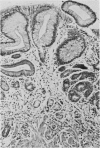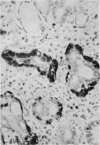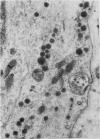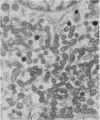Abstract
There is a recognised association between pernicious anaemia and the development of gastric carcinoma, endocrine cell hyperplasia, and carcinoid tumour. Multiple endoscopic biopsies from the body mucosa of seven patients with pernicious anaemia showed small intestinal metaplasia with varying degrees of inflammation, fibrosis, and expansion of the lamina propria. Using conventional silver and lead stains, endocrine cells were inconspicuous. Staining for the general neural and neuroendocrine markers NSE and PGP 9.5 revealed a proliferation of endocrine cells in the epithelium and isolated clumps of endocrine cells in the lamina propria. The clumps were composed of two cell types, either small or large. Some of these endocrine cells showed gastrin, 5HT, VIP and substance P immunoreactivity of varying intensity. Ultrastructurally nine morphologically distinct types of granules were found some of which correlated with the immunohistochemistry. Some separate islands were composed solely of endocrine cells while others had a definite neural component, suggesting that the former arise from 'budding off' of enteroendocrine cells and the latter originate from the neuroendocrine cells of the lamina propria plexus. Thus there may be a dual origin of carcinoid tumours. Carcinoid tumours associated with pernicious anaemia tend to be multifocal and are infrequent. Less than 50 such cases have hitherto been reported. Our findings of endocrine cells proliferations in seven cases of pernicious anaemia indicate that this may be an adaptive change that occurs frequently and provides the basis on which carcinoids, less frequently, develop.
Full text
PDF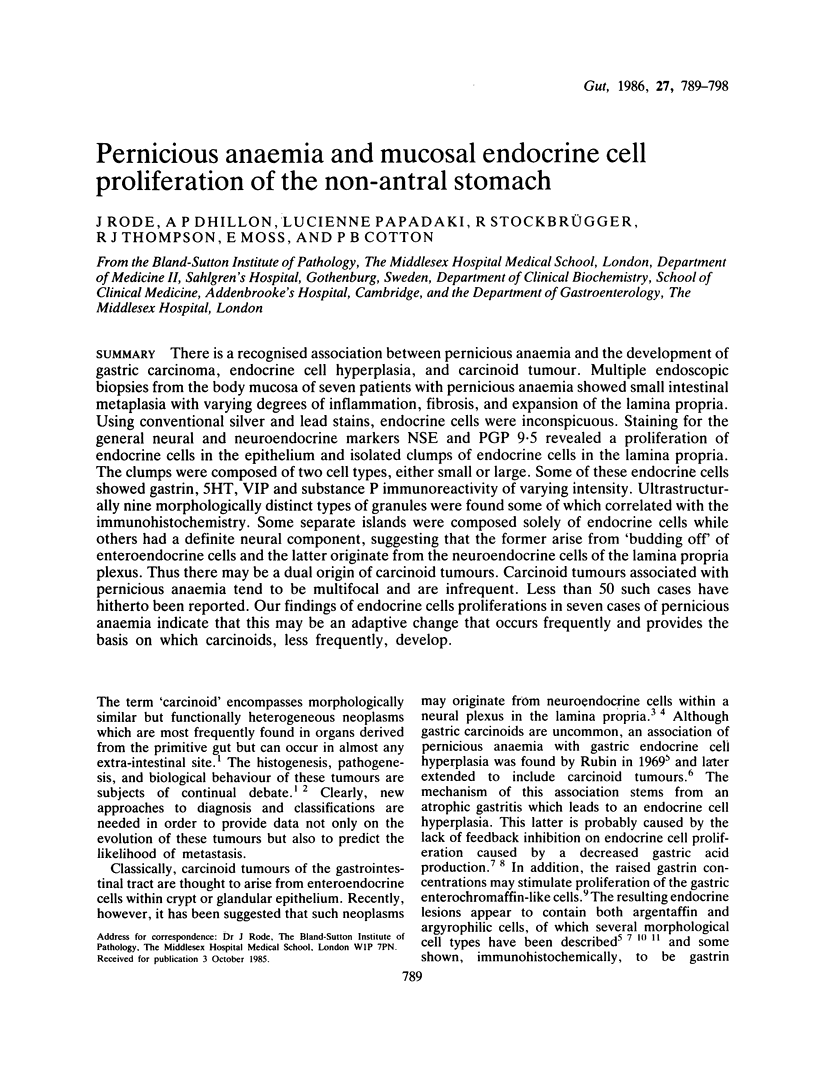
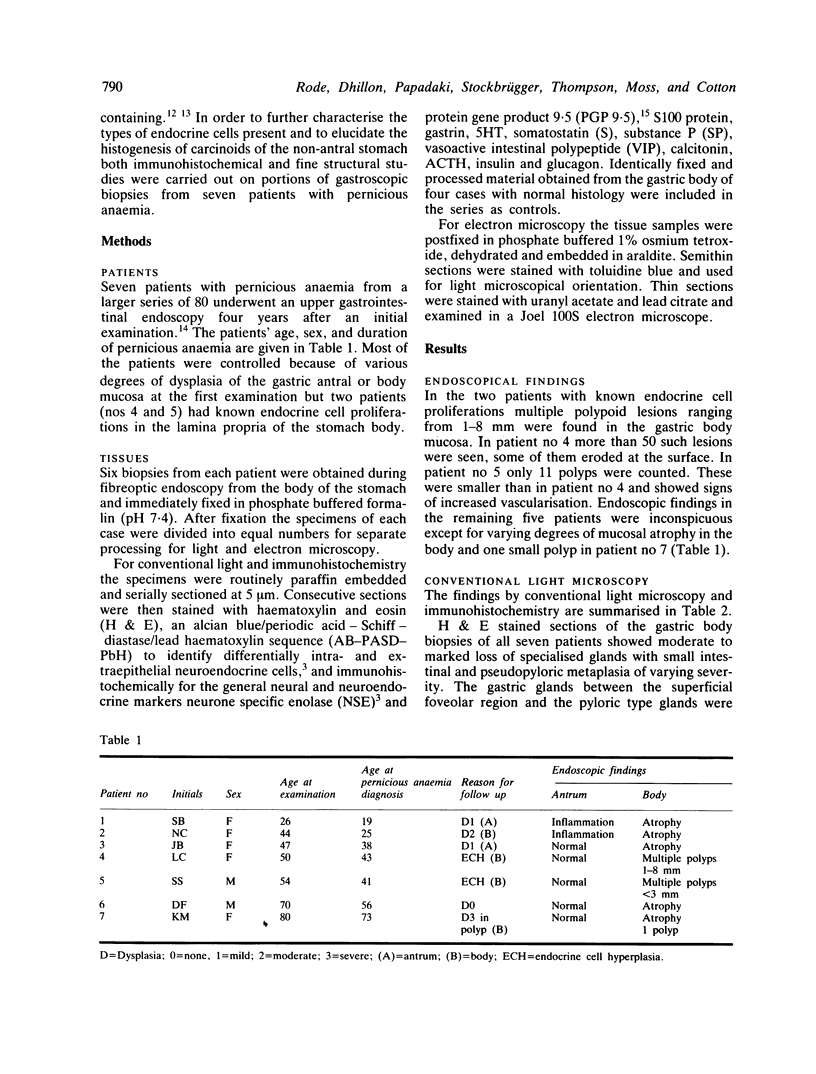
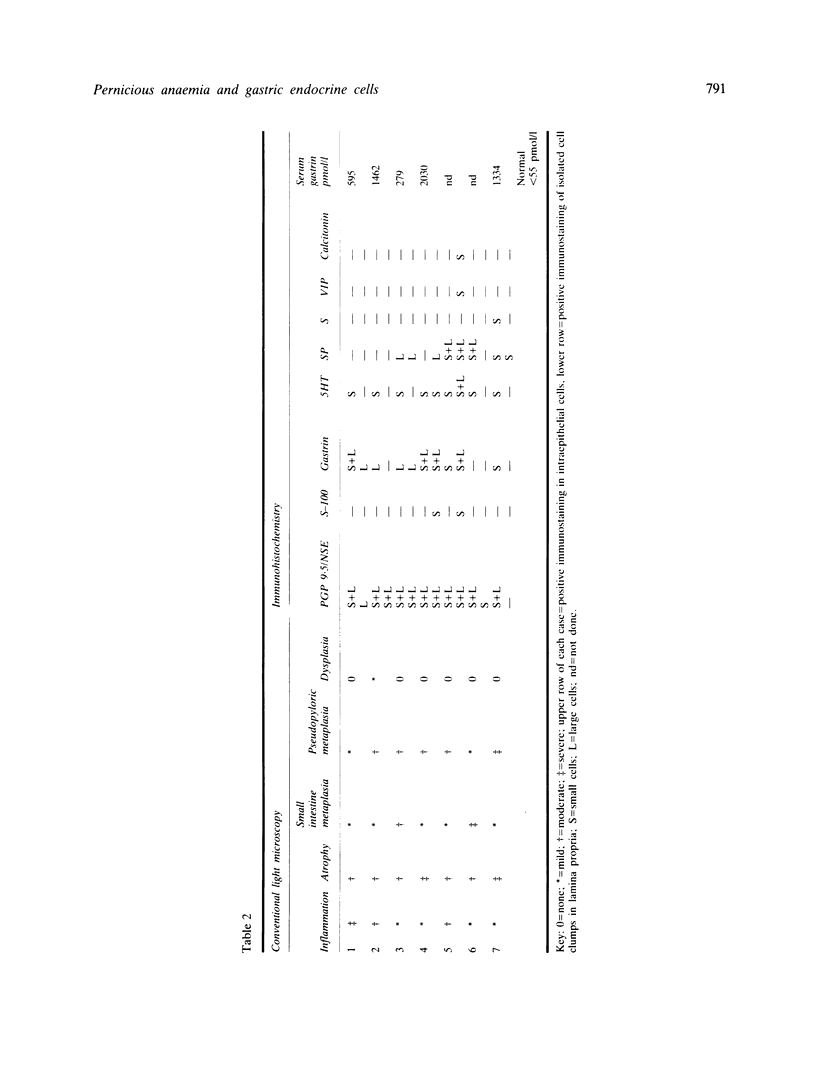
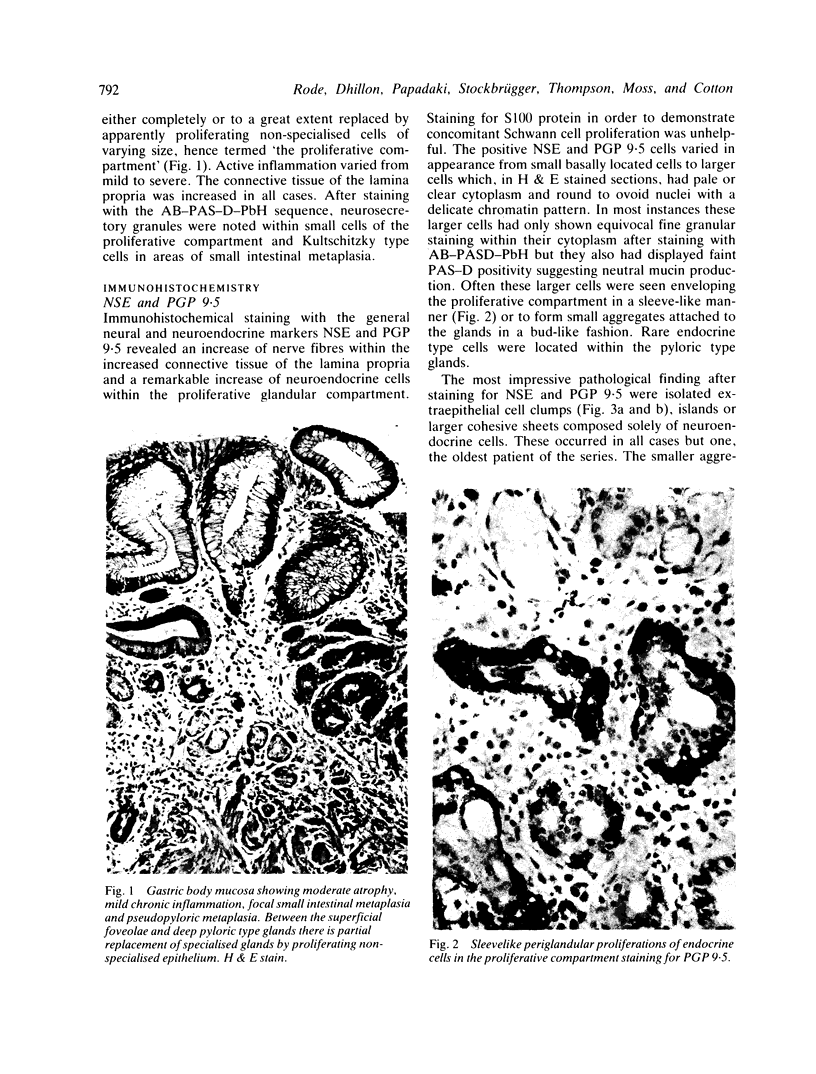
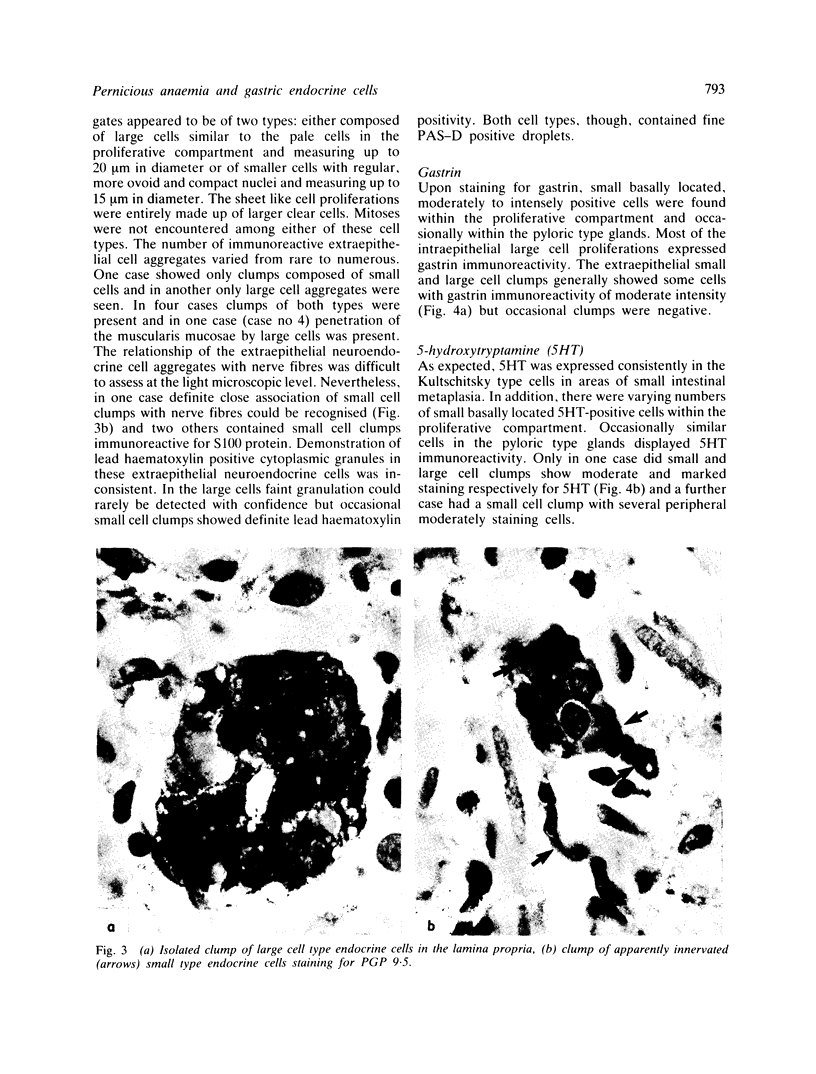
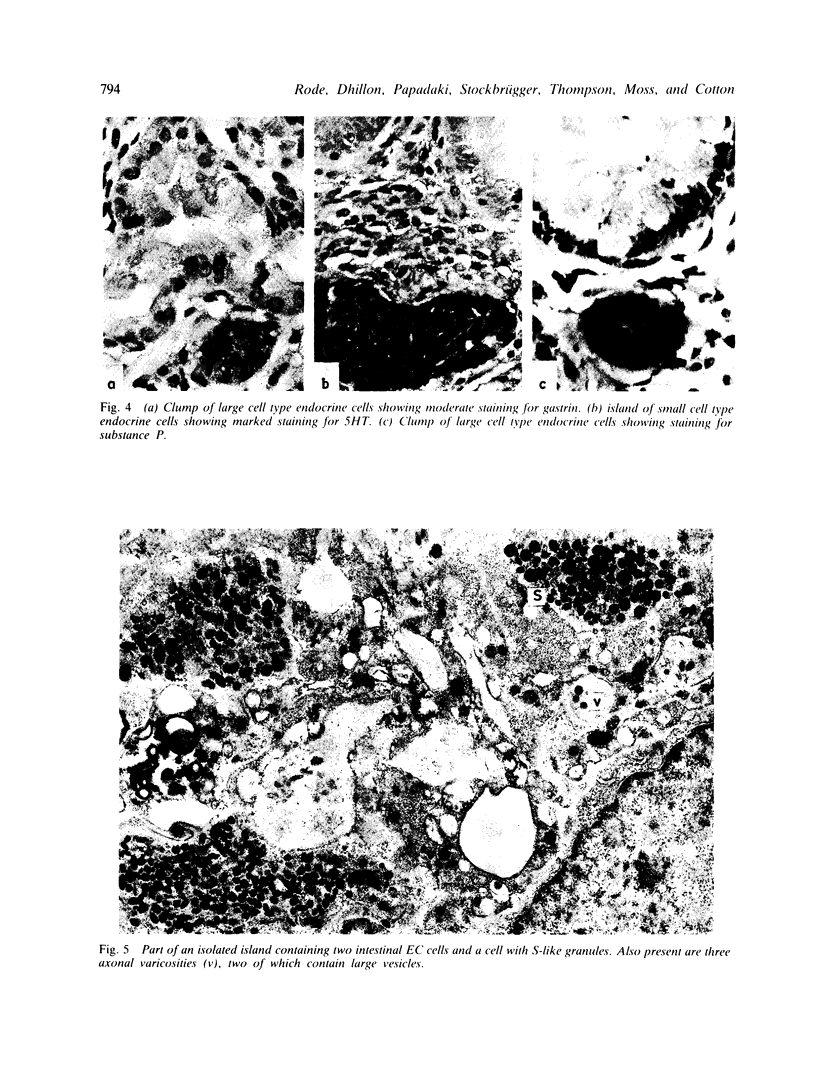
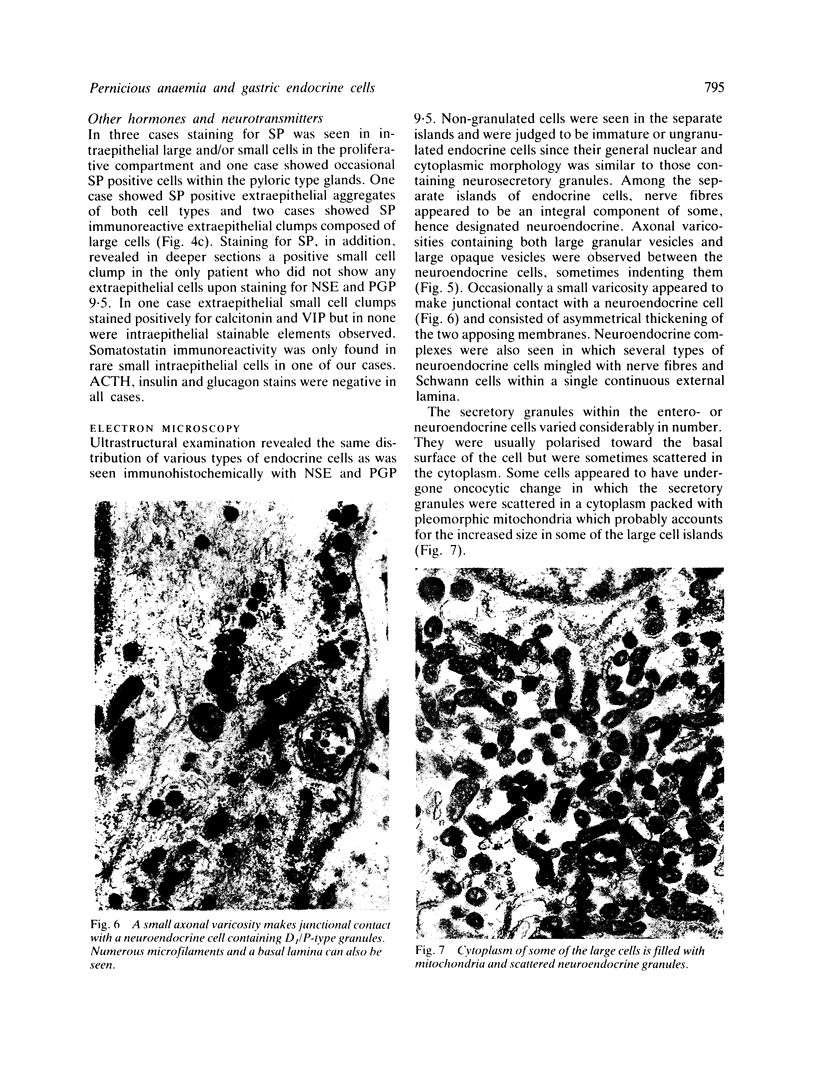
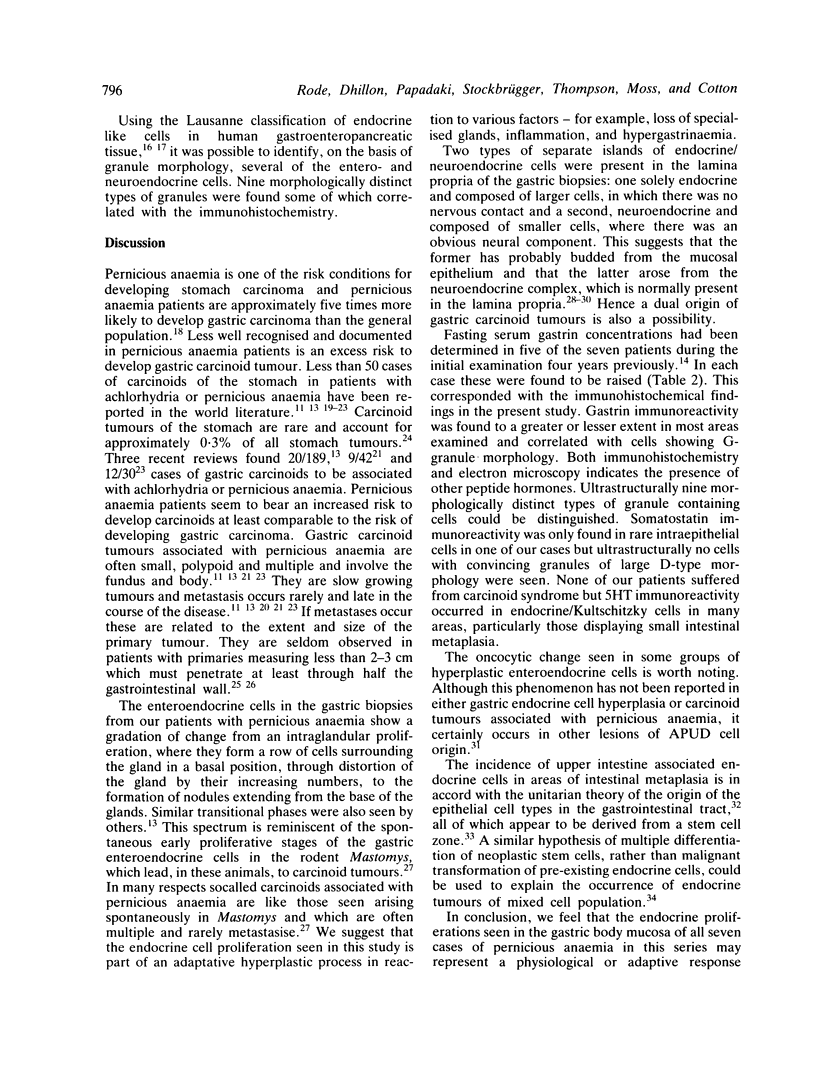
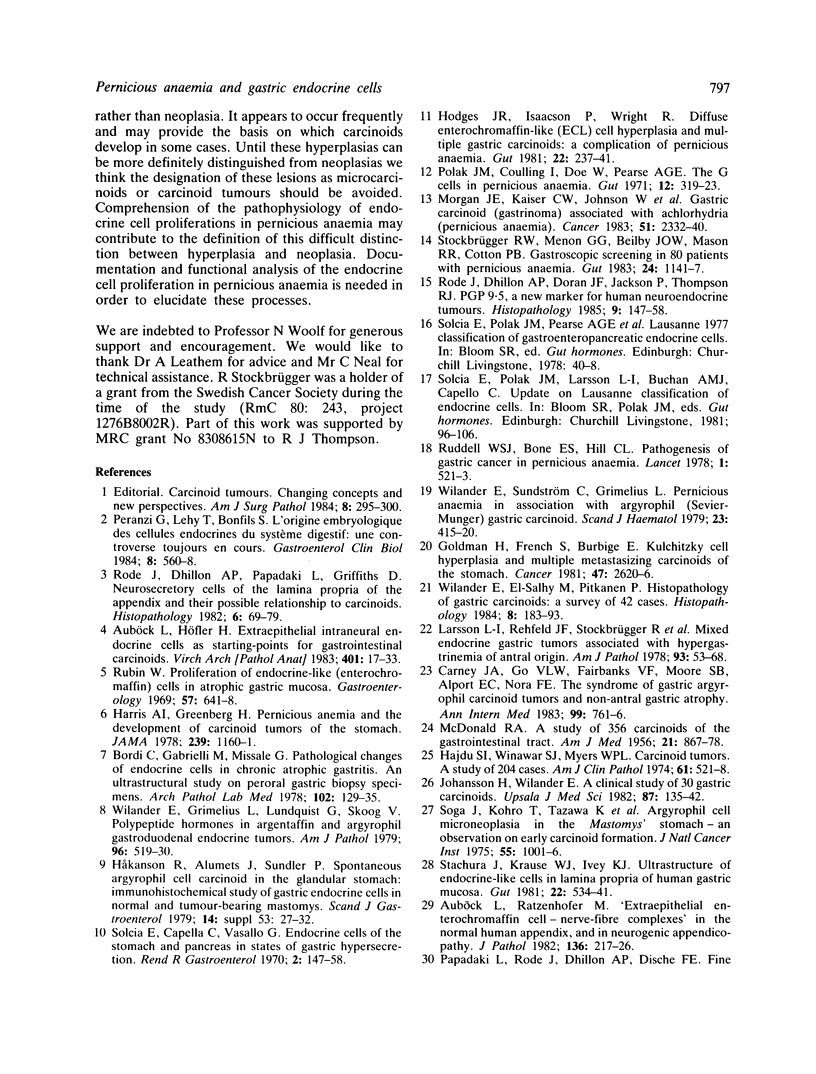
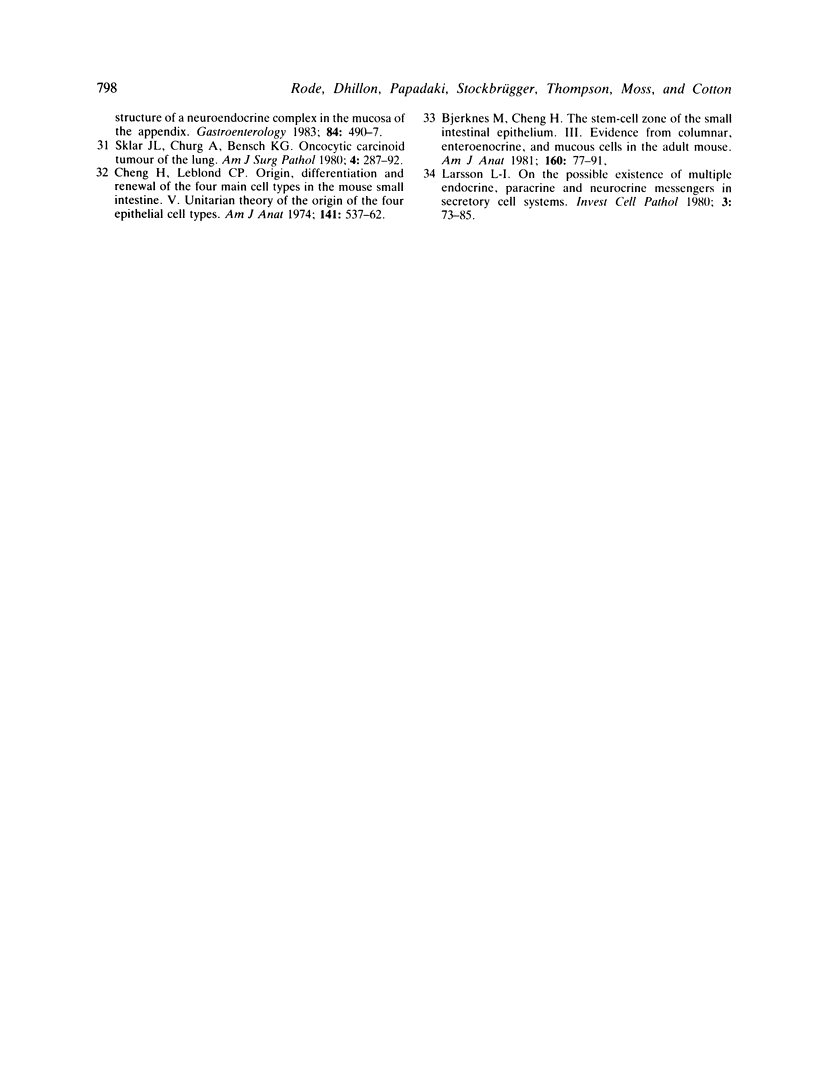
Images in this article
Selected References
These references are in PubMed. This may not be the complete list of references from this article.
- Auböck L., Höfler H. Extraepithelial intraneural endocrine cells as starting-points for gastrointestinal carcinoids. Virchows Arch A Pathol Anat Histopathol. 1983;401(1):17–33. doi: 10.1007/BF00644786. [DOI] [PubMed] [Google Scholar]
- Auböck L., Ratzenhofer M. "Extraepithelial enterochromaffin cell--nerve-fibre complexes" in the normal human appendix, and in neurogenic appendicopathy. J Pathol. 1982 Mar;136(3):217–226. doi: 10.1002/path.1711360305. [DOI] [PubMed] [Google Scholar]
- Bjerknes M., Cheng H. The stem-cell zone of the small intestinal epithelium. III. Evidence from columnar, enteroendocrine, and mucous cells in the adult mouse. Am J Anat. 1981 Jan;160(1):77–91. doi: 10.1002/aja.1001600107. [DOI] [PubMed] [Google Scholar]
- Bordi C., Gabrielli M., Missale G. Pathologic changes of endocrine cells in chronic atrophic gastritis. An ultrastructural study on peroral gastric biopsy specimens. Arch Pathol Lab Med. 1978 Mar;102(3):129–135. [PubMed] [Google Scholar]
- Carney J. A., Go V. L., Fairbanks V. F., Moore S. B., Alport E. C., Nora F. E. The syndrome of gastric argyrophil carcinoid tumors and nonantral gastric atrophy. Ann Intern Med. 1983 Dec;99(6):761–766. doi: 10.7326/0003-4819-99-6-761. [DOI] [PubMed] [Google Scholar]
- Cheng H., Leblond C. P. Origin, differentiation and renewal of the four main epithelial cell types in the mouse small intestine. V. Unitarian Theory of the origin of the four epithelial cell types. Am J Anat. 1974 Dec;141(4):537–561. doi: 10.1002/aja.1001410407. [DOI] [PubMed] [Google Scholar]
- Goldman H., French S., Burbige E. Kulchitsky cell hyperplasia and multiple metastasizing carcinoids of the stomach. Cancer. 1981 Jun 1;47(11):2620–2626. doi: 10.1002/1097-0142(19810601)47:11<2620::aid-cncr2820471117>3.0.co;2-#. [DOI] [PubMed] [Google Scholar]
- Hajdu S. I., Winawer S. J., Myers W. P. Carcinoid tumors. A study of 204 cases. Am J Clin Pathol. 1974 Apr;61(4):521–528. doi: 10.1093/ajcp/61.4.521. [DOI] [PubMed] [Google Scholar]
- Harris A. I., Greenberg H. Pernicious anemia and the development of carcinoid tumors of the stomach. JAMA. 1978 Mar 20;239(12):1160–1161. [PubMed] [Google Scholar]
- Hodges J. R., Isaacson P., Wright R. Diffuse enterochromaffin-like (ECL) cell hyperplasia and multiple gastric carcinoids: a complication of pernicious anaemia. Gut. 1981 Mar;22(3):237–241. doi: 10.1136/gut.22.3.237. [DOI] [PMC free article] [PubMed] [Google Scholar]
- Håkanson R., Alumets J., Sundler F. Spontaneous argyrophil cell carcinoid in the glandular stomach: immunohistochemical study of gastric endocrine cells in normal and tumour-bearing mastomys. Scand J Gastroenterol Suppl. 1979;53:27–32. [PubMed] [Google Scholar]
- Johansson H., Wilander E. A clinical study of 30 gastric carcinoids. Ups J Med Sci. 1982;87(2):135–142. doi: 10.3109/03009738209178418. [DOI] [PubMed] [Google Scholar]
- Larsson L. I., Rehfeld J. F., Stockbrügger R., Blohme G., Schön I. M., Lundqvist G., Kindblom L. G., Säve-Söderberg J., Grimelius L., Olbe L. Mixed endocrine gastric tumors associated with hypergastrinemia of antral origin. Am J Pathol. 1978 Oct;93(1):53–68. [PMC free article] [PubMed] [Google Scholar]
- MACDONALD R. A. A study of 356 carcinoids of the gastrointestinal tract; report of four new cases of the carcinoid syndrome. Am J Med. 1956 Dec;21(6):867–878. doi: 10.1016/0002-9343(56)90101-2. [DOI] [PubMed] [Google Scholar]
- Morgan J. E., Kaiser C. W., Johnson W., Doos W. G., Dayal Y., Berman L., Nabseth D. Gastric carcinoid (gastrinoma) associated with achlorhydria (pernicious anemia). Cancer. 1983 Jun 15;51(12):2332–2340. doi: 10.1002/1097-0142(19830615)51:12<2332::aid-cncr2820511228>3.0.co;2-i. [DOI] [PubMed] [Google Scholar]
- Papadaki L., Rode J., Dhillon A. P., Dische F. E. Fine structure of a neuroendocrine complex in the mucosa of the appendix. Gastroenterology. 1983 Mar;84(3):490–497. [PubMed] [Google Scholar]
- Polak J. M., Doe W., Coulling I., Pearse A. G. The G cells in pernicious anaemia. Gut. 1971 Apr;12(4):319–323. doi: 10.1136/gut.12.4.319. [DOI] [PMC free article] [PubMed] [Google Scholar]
- Péranzi G., Lehy T., Bonfils S. L'origine embryologique des cellules endocrines du système digestif: une controverse toujours en cours. Gastroenterol Clin Biol. 1984 Jun-Jul;8(6-7):560–568. [PubMed] [Google Scholar]
- Rbin W. Proliferation of endocrine-like enterochromaffin) cells in atrophic gastri mucosa. Gastroenterology. 1969 Dec;57(6):641–648. [PubMed] [Google Scholar]
- Rode J., Dhillon A. P., Doran J. F., Jackson P., Thompson R. J. PGP 9.5, a new marker for human neuroendocrine tumours. Histopathology. 1985 Feb;9(2):147–158. doi: 10.1111/j.1365-2559.1985.tb02431.x. [DOI] [PubMed] [Google Scholar]
- Rode J., Dhillon A. P., Papadaki L., Griffiths D. Neurosecretory cells of the lamina propria of the appendix and their possible relationship to carcinoids. Histopathology. 1982 Jan;6(1):69–79. doi: 10.1111/j.1365-2559.1982.tb02703.x. [DOI] [PubMed] [Google Scholar]
- Ruddell W. S., Bone E. S., Hill M. J., Walters C. L. Pathogenesis of gastric cancer in pernicious anaemia. Lancet. 1978 Mar 11;1(8063):521–523. doi: 10.1016/s0140-6736(78)90550-0. [DOI] [PubMed] [Google Scholar]
- Sklar J. L., Churg A., Bensch K. G. Oncocytic carcinoid tumor of the lung. Am J Surg Pathol. 1980 Jun;4(3):287–292. doi: 10.1097/00000478-198006000-00011. [DOI] [PubMed] [Google Scholar]
- Soga J., Koro T., Tazawa K., Kanahara H., Sano M. Argyrophil cell microneoplasia in the Mastomys' stomach--an observation on early carcinoid formation. J Natl Cancer Inst. 1975 Oct;55(4):1001–1006. doi: 10.1093/jnci/55.4.1001. [DOI] [PubMed] [Google Scholar]
- Stachura J., Krause W. J., Ivey K. J. Ultrastructure of endocrine-like cells in lamina propria of human gastric mucosa. Gut. 1981 Jul;22(7):534–541. doi: 10.1136/gut.22.7.534. [DOI] [PMC free article] [PubMed] [Google Scholar]
- Stockbrügger R. W., Menon G. G., Beilby J. O., Mason R. R., Cotton P. B. Gastroscopic screening in 80 patients with pernicious anaemia. Gut. 1983 Dec;24(12):1141–1147. doi: 10.1136/gut.24.12.1141. [DOI] [PMC free article] [PubMed] [Google Scholar]
- Wilander E., El-Salhy M., Pitkänen P. Histopathology of gastric carcinoids: a survey of 42 cases. Histopathology. 1984 Mar;8(2):183–193. doi: 10.1111/j.1365-2559.1984.tb02335.x. [DOI] [PubMed] [Google Scholar]
- Wilander E., Grimelius L., Lundqvist G., Skoog V. Polypeptide hormones in argentaffin and argyrophil gastroduodenal endocrine tumors. Am J Pathol. 1979 Aug;96(2):519–530. [PMC free article] [PubMed] [Google Scholar]
- Wilander E., Sundström C., Grimelius L. Pernicious anaemia in association with argyrophil (Sevier-Munger) gastric carcinoid. Scand J Haematol. 1979 Nov;23(5):415–420. doi: 10.1111/j.1600-0609.1979.tb02742.x. [DOI] [PubMed] [Google Scholar]



